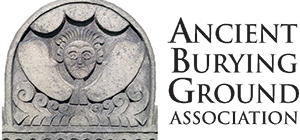Images began to appear on Connecticut gravestones late in the 1600s. Stones from this period into the early 1700s evolved from crudely simple heads into a fully realized, forbidding, grimacing skull, with hollow eyes, arched batlike wings, and sometimes surrounding decoration. Known among modern gravestone scholars as “death’s heads,” these are believed to reflect early Puritans’ grim attitude toward human mortality, emphasizing impending, unavoidable death, and the subsequent decay of the physical body.
Gravestones were the primary form of sculpture produced in early New England. The carvers were folk artists each of whom started with the same symbolic image, then rendered it in his own personal, distinctive style.
The style of the lettering, the decorative work on the tympanum and along the edges and bottoms of stones – pin-wheels, clovers, hearts, diamonds, scallops, vines, and more – also could reflect the work of a particular carver. The size and quality of the carving on a stone also reflected the financial prosperity and social status of the deceased.
The style of an individual carver could develop and change over the course of his career. The work of more than 40 different carvers is represented in the Ancient Burying Ground.
Hezekiah Brainard, 1727
“HERE LYETH BURYED ye BODY OF HEZEKIAH BRAINERD Assistant Who Died May ye 24 A.D. 1727 Aged 46 Years“
Hezekiah Brainard’s stone was the work of Thomas Johnson of Middletown, the first member of a dynasty of three generations of stone carvers. Menacing faces, triangular noses, and border panels of figlike designs and pin wheels characterized his carving.
Hezekiah Brainard of Haddam, Connecticut, was in Hartford attending a session of the Upper House of the Connecticut legislature in May of 1727 when he fell ill with some unrecorded illness. He died a week later. Transporting the body the more than 25 miles to Haddam in the late spring weather would have been difficult and time-consuming. Brainard was laid to rest in the Ancient Burying Ground. The Connecticut legislature appropriated ten pounds toward the cost of his burial.
Related Resources:
Makers of the Markers Brochure (below) identifies some of the carvers whose work can be seen at the Ancient Burying Ground.
